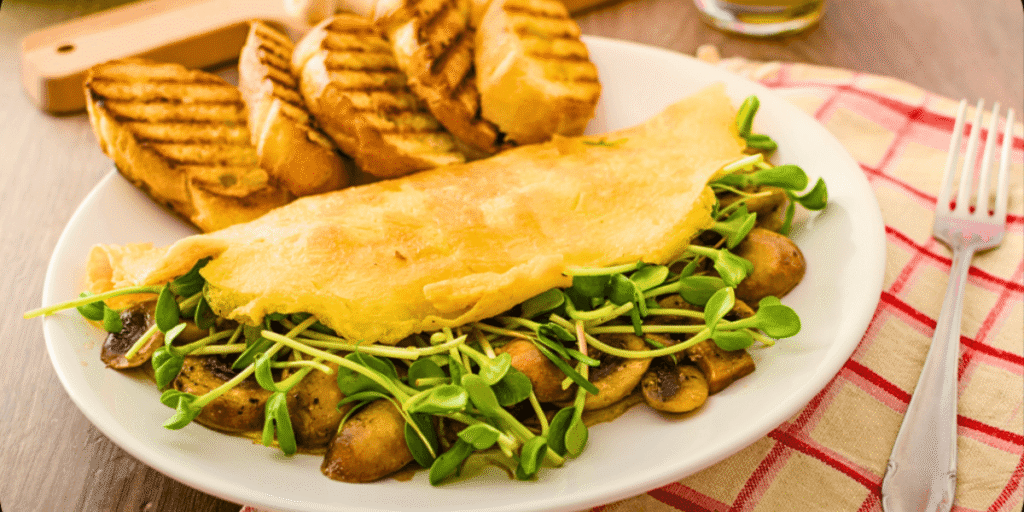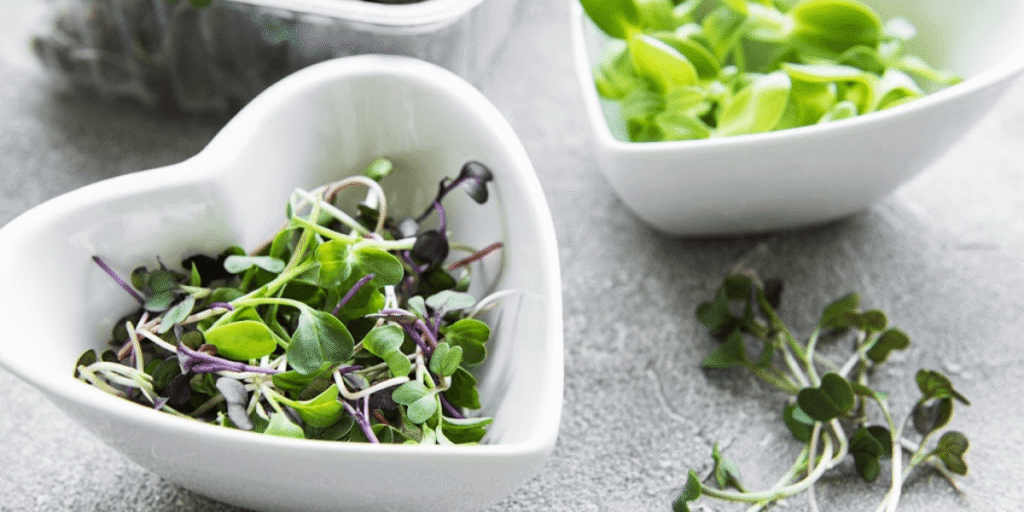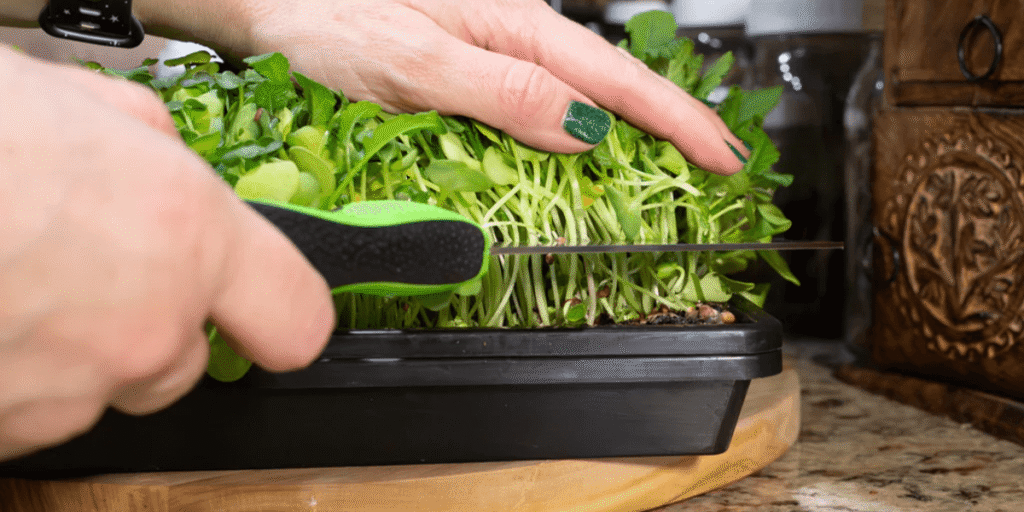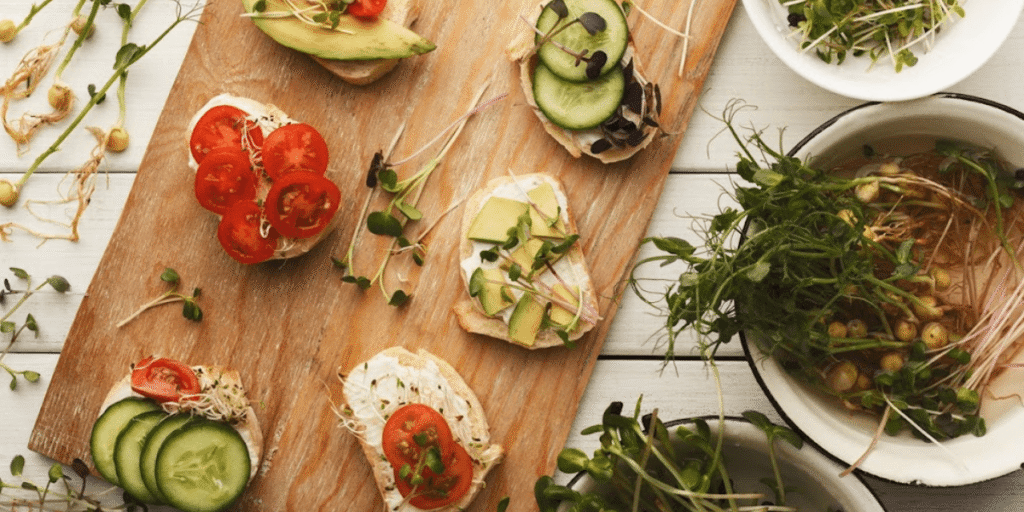Use microgreens in meals to unlock their full potential beyond just a salad garnish. These tiny greens have earned their reputation as a “superfood” thanks to their incredible nutritional density and vibrant flavor. Once you have a fresh batch, you might wonder how to best enjoy them.
Moving beyond simple toppings, microgreens offer an exciting and easy way to add flavor, texture, and a powerful nutritional boost to almost any dish. Here are some of the best ways to incorporate microgreens into your daily cooking and transform ordinary meals into culinary masterpieces.
Why Use Microgreen in Meal for Better Nutrition
Microgreens are basically baby plants, tiny young vegetable greens that are harvested shortly after they sprout, usually about one to two weeks in. Even though they look small and delicate, they are actually packed with nutrients. In fact, many microgreens have much higher concentrations of vitamins, minerals, and antioxidants compared to their fully grown versions. This means you get a powerful nutritional boost from just a small handful.
What is more, microgreens bring fresh, vibrant flavors to your meals. They can add a nice crunch or a subtle peppery taste that livens up everything from salads to sandwiches. The best part is how easy they are to use. You do not need to make big changes to your diet, just sprinkle some microgreens on your dishes, and you are adding natural goodness in a simple, tasty way. Whether you are blending them into smoothies, topping soups, or mixing them into your favorite recipes, microgreens make eating healthy feel effortless and enjoyable.
Quick & Easy Microgreens Toppings for Everyday Meals
These are super simple ways to add a fresh, final touch to any meal, with no fuss and just flavor. The secret is to always add microgreens right before serving so they stay crisp and packed with nutrients.
- Salads and Bowls: Microgreens aren’t just pretty garnishes; they can totally be the star. Use a big mix of microgreens as your salad base or sprinkle them over grain bowls to add an extra crunch and boost of flavor.
- Sandwiches, Wraps, and Tacos: Tired of plain old lettuce? Swap it out for a handful of microgreens. Peppery radish or arugula microgreens add a nice kick to turkey sandwiches or fish tacos, while milder pea shoots are perfect for keeping chicken wraps light and fresh.
- Soups and Stews: Hot soups will wilt delicate microgreens fast, so the trick is to add them just before you dig in. Whether it’s creamy tomato soup, spicy lentil stew, or a hearty bowl of ramen, a sprinkle of microgreens adds a pop of color and a refreshing contrast.
- Avocado Toast and Eggs: This combo is a classic for good reason. Pile your favorite microgreens on top of freshly mashed avocado toast. And don’t forget eggs. Whether it’s an omelet, scrambled eggs, or frittata, add microgreens after cooking to brighten up the flavor.

Creative Ways to Use Microgreens in Your Recipes
Ready to get a little adventurous? These ideas go beyond just sprinkling microgreens on top. You actually mix them right into your dishes to boost both flavor and nutrition.
While all microgreens are packed with nutrients, certain varieties are particularly effective at helping you achieve specific health and wellness goals.
- Smoothies and Juices: If you want an easy way to sneak in extra nutrients without changing the taste much, just toss a handful of microgreens into your blender. Milder kinds like pea shoots or sunflower microgreens work best because they will not overpower your fruit or protein.
- Pestos and Dressings: Microgreens make a fantastic swap for herbs in sauces and dressings. Next time you make pesto, try replacing some of the basil with basil microgreens and a bit of spinach. You will get a richer flavor and a big nutrition boost.
- Burgers and Meatballs: Want to make your burgers or meatballs healthier? Finely chop some microgreens and mix them right into your ground meat before shaping the patties. This works great for beef or veggie burgers and adds extra vitamins and fiber without changing the taste too much.
Main Dishes Featuring Microgreens for Extra Flavor
Microgreens can really shine in main dishes as long as you treat them gently and with care.
- Pasta and Risotto: Rich and creamy dishes like pasta and risotto get a fresh boost when you fold in a handful of microgreens just as you turn off the heat. The gentle warmth wilts them slightly, keeping their delicate texture while adding a bright, fresh flavor.
- Pizza: Don’t toss microgreens in the oven that’ll kill their nutrients and crispness. Instead, sprinkle them over your pizza right after it comes out. The warm cheese and crust soften the microgreens just enough, giving you a fresh, slightly crunchy bite that livens up every slice.
Tips for Maximizing Microgreens Nutrition in Meals
Microgreens can really shine in main dishes as long as you treat them gently and with care.
- Store Properly: To keep your microgreens fresh longer, don’t wash them until you’re ready to use them. Store them unwashed in a sealed container lined with a dry paper towel inside the fridge. The paper towel soaks up extra moisture, preventing the microgreens from wilting or going soggy too quickly. This simple step can extend their shelf life and keep them tasting crisp and vibrant.
- Don’t Cook Them: The vitamins and delicate nutrients in microgreens, like Vitamin C, are very sensitive to heat and can easily be destroyed when cooked. To get the most health benefits and keep that fresh flavor, avoid cooking microgreens. Instead, add them right at the end of cooking or use them raw in salads, sandwiches, or smoothies. This way, you get all the goodness without losing any of their bright taste.
- Match the Flavor: Think of microgreens like natural spices or herbs. Spicy varieties like radish or mustard microgreens pair perfectly with grilled meats and fish, adding a nice kick and complexity. Milder options like pea shoots or sunflower microgreens work great in salads and smoothies, offering a subtle sweetness and fresh texture without overpowering other ingredients. Experiment with different types to find the combinations that best suit your dishes.

How Microgreens Support Specific Health Goals
While all microgreens are packed with nutrients, certain varieties are particularly effective at helping you achieve specific health and wellness goals.
- Boosting Your Immune System: Microgreens from the Brassica family, like broccoli, kale, and red cabbage, are loaded with vitamins A, C, E, and K, plus powerful antioxidants. These help strengthen your body’s defenses, making it easier to fight off illness and reduce inflammation.
- Supporting Gut Health and Digestion: Microgreens are a great source of dietary fiber and live enzymes that aid digestion. They also help feed the good bacteria in your gut, promoting a balanced and healthy microbiome. Pea shoots and sunflower microgreens are especially rich in fiber that supports your digestive system.
- Glowing Skin and Fighting Aging: The antioxidants packed in microgreens, particularly varieties like arugula and radish, help combat free radicals. By reducing oxidative stress, these tiny greens protect your skin from damage, promote a healthy glow, and help slow down signs of premature aging.
Save Money with Homegrown Microgreens for Your Meals
Microgreens at the store can be pretty pricey they’re often treated like a specialty item, and the price tag shows it. But if you start growing your own at home, you’ll quickly see it’s actually a really smart way to save money.
Here’s the deal: a small plastic container of microgreens from the grocery store usually costs between $4 and $8. But if you buy seeds in bulk, that same amount can grow fresh microgreens for months, even years. The upfront cost for a basic setup, just a tray and some growing medium pays for itself after a few harvests.
Plus, growing your own means no more wasting money on greens that go bad before you get to eat them. You pick exactly what you need, when you need it, so everything is fresh, tasty, and ready to enjoy.
The Sustainable Choice: Growing Microgreens at Home
Growing your own microgreens is a simple but powerful way to shrink your environmental footprint. It is an easy way to join the movement toward a more sustainable food system with no fancy equipment or big changes needed.
Think about it. When you grow microgreens at home, you are cutting out all those plastic clamshell containers that come with store-bought greens. That means less plastic trash piling up in landfills and oceans. Plus, you get fresh, tasty greens without any guilt about packaging waste.
And here is a bonus. Your microgreens do not have to travel thousands of miles to get to your plate. Growing them right on your kitchen counter means zero food miles and zero transport emissions. It is literally farm to table in just a few feet.
If you use a hydroponic setup, you will also save a ton of water compared to traditional farming. Hydroponics recycles water and nutrients in a closed system so there is minimal waste. It is a smart, eco-friendly way to grow your food even in a small space.
Beginner’s Guide: How to Use and Grow Microgreens
If you’re new to growing microgreens, it can feel a bit overwhelming at first. Luckily, we have a detailed guide called How to Grow Microgreens Hydroponically that breaks down the entire process step by step.
From choosing the right seeds and setting up your growing space to caring for your plants every day and knowing when to harvest, this guide covers it all. It’s designed to make growing microgreens at home simple and enjoyable, even if you’ve never done it before.
Whether you want to try a small tray on your windowsill or set up a more advanced hydroponic system, this article will give you the confidence and knowledge to get started and succeed. Give it a read and start your journey to fresh, nutrient-packed greens today!

FAQs About Using Microgreens in Meals
Q1: How should I wash microgreens?
A1: Microgreens are really delicate so don’t soak them in water. Just put them in a colander and give them a quick rinse with cool water. Then gently pat them dry with a paper towel or use a salad spinner to get rid of extra moisture. Otherwise, the leaves might get soggy.
Q2: Can I cook microgreens?
A2: It’s better not to cook them at high heat because that can kill the nutrients and make them mushy. The best way is to add microgreens at the very end of cooking or just eat them raw. They taste fresh and keep all their goodness that way.
Q3: How do I store microgreens so they last?
A3: Don’t wash them before storing or they’ll get soggy fast. Keep them dry and put them in a sealed container lined with a paper towel to soak up moisture. Then put the container in the fridge, preferably in the vegetable drawer. They can stay fresh for about five or six days like that.
Q4: What is the difference between microgreens and sprouts?
A4: Microgreens are tiny plants that have leaves and a stronger flavor. Sprouts are just germinated seeds that are softer and milder in taste. If you want a crunchy bite and bold flavor, go for microgreens. If you want something tender and mild, sprouts are the way to go.
Q5: What microgreens are good for beginners?
A5: Pea shoots, sunflower, and broccoli microgreens are great for beginners. They have mild, slightly sweet flavors that go well with almost anything and aren’t overpowering.
Conclusion: Embrace Microgreens in Your Daily Cooking
Microgreens are surprisingly versatile and super easy to add into your daily meals. They are not just pretty little garnishes. When you use them more creatively, they can completely change the way your food tastes and feels. Whether you toss them into salads, sprinkle them on sandwiches, mix them into smoothies, or fold them gently into warm dishes, microgreens bring a fresh burst of flavor and a satisfying crunch.
Beyond taste and texture, microgreens pack a serious nutritional punch. These tiny greens are loaded with vitamins, antioxidants, and fiber, making them a simple way to boost your health without any complicated prep or extra effort. Growing your own microgreens is even better. It means you always have fresh, nutrient-rich greens ready to go and you can save money while doing something good for the planet.
So why not embrace microgreens as a regular part of your cooking? They are an easy, tasty, and healthy upgrade that can brighten up even the simplest meals and make eating well feel like a true pleasure.
Ready to Start Using Microgreens in Your Meals?
Want to discover how to effortlessly add microgreens to your everyday meals and turn simple dishes into healthy, flavorful delights? Check out our blog How to Use Microgreens in Everyday Meal for easy tips and plenty of recipe inspiration to help you bring vibrant, tasty greens to your table!
Whether you’re new to microgreens or already a devoted fan, we’d love to hear from you. Feel free to email us at info@greenfuturehydro.com or give us a call at +86 13487543942 with your questions, ideas, or just to say hello. Greenfuturehydro is here to support you on your journey to a healthier, greener lifestyle.
Looking to start growing your own microgreens? Explore our range of hydroponic products designed to make growing fresh greens simple and fun. Visit our hydroponic products page here and find the perfect setup for your home garden.
Don’t forget to follow us on Instagram @Greenfuturehydro for even more creative microgreen recipes and handy tips. Join our growing community, share your photos and stories, and show us how you’re adding a little green magic to your meals. We can’t wait to see what you create!

